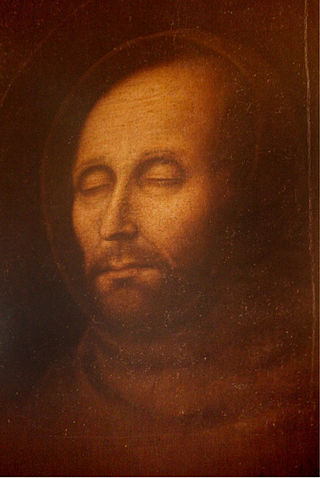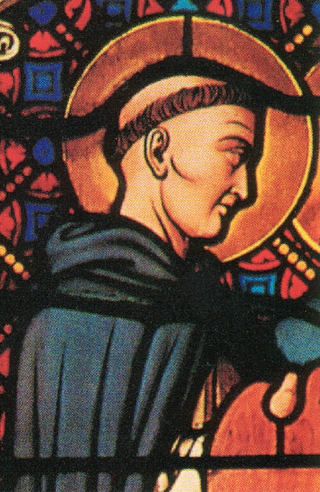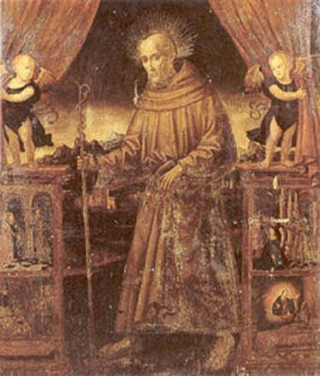Giovanni Battista Righi was an Italian Roman Catholic priest and a professed member from the Order of Friars Minor. He was known for ascetic life and for his preaching and healing abilities.

Innocenzo da Berzo, born Giovanni Scalvinoni, was an Italian Roman Catholic priest and a professed member of the Order of Friars Minor. Scalvinoni assumed his new religious name upon his profession as a Capuchin friar.

Jakub Strzemię was a Polish Roman Catholic archbishop and a professed member of the Order of Friars Minor. He served as the Archbishop of Halicz from 1392 until his death when the archdiocese was incorporated into that of the Archdiocese of Lviv.

Blessed Ladislas of Gielniów was a Polish Roman Catholic priest and a professed member of the Order of Friars Minor. He was an observant of the Rule of Saint Francis of Assisi and served his order in various capacities that included both a doorkeeper and as its provincial. He also travelled across Poland to evangelize to the faithful and was a noted preacher.

Ugolino da Gualdo Cattaneo was an Italian Roman Catholic professed religious and friar of the Order of Saint Augustine. Ugolino is best known for founding an Augustinian convent in Gualdo Cattaneo in 1258 where he served as its prior until his death. He practiced a rigorous spiritual life with austerities including frequent bouts of strict silence and fasting.

Francesco Lippi was an Italian Roman Catholic professed religious from the Carmelites. He lived his life as a soldier before suffering the loss of sight at which point his healing led him down the path of repentance and into the Carmelites.

Antonio Patrizi was an Italian Roman Catholic priest and a professed member of the Order of Saint Augustine. Patrizi joined the order in Lecceto and lived as a hermit prior to his sudden death while visiting his friend at another convent.

Guala de Roniis was an Italian catholic priest and a professed member of the Order of Preachers as one of Dominic of Osma's earliest disciples. De Roniis was born as a noble and was appointed as the Bishop of Brescia after Dominic's death though also served as a popular papal legate that earned him popular and papal support. He resigned from his episcopal see to dedicate the remainder of his life to peaceful solitude though his reputation for personal holiness prompted countless people to seek him out for his counsel.

Giacomo Bianconi was an Italian Roman Catholic priest and a professed member of the Order of Preachers. Bianconi - who hailed from Umbria - joined the order in his adolescence and dedicated his pastoral career to his flock and on one notable occasion aided refugees when Frederick II sacked the area in 1248. He also combatted heresies and managed to convert one of their chief propagators while also distinguishing himself through his life of extreme poorness that went past the Dominican standards.

Benincasa da Montepulciano was an Italian Roman Catholic professed religious from the Servite Order. He lived as a hermit in Siena his entire life since he joined the order as a teenager and dedicated himself to a quiet life of servitude to God in contemplation despite still receiving visitors and orders from his superiors.
Elena Valentinis was an Italian Roman Catholic professed religious from the tertiaries of the Order of Saint Augustine. Valentinis was born to nobles and married a knight during her adolescence while mothering six children before she was widowed in 1441. She soon became a professed religious and dedicated herself to austerities and a life of complete penance.
Giovanni da Penna was an Italian Roman Catholic priest and a professed member of the Order of Friars Minor. He became a Franciscan in 1213 after hearing Fra Filippo - one of the disciples of Francis of Assisi - preach. He spent over two decades in France where he oversaw the establishment of Franciscan houses before returning to the Italian peninsula where he served his life in quiet cloistered retirement.

Lorenzo da Ripafratta was an Italian Roman Catholic professed religious from the Order of Preachers. He was born to nobles in Pisa and served as a novice master in Cortona in the latter half of his career while distinguishing himself in aiding the ill during times of the plague in both Pistoia and Fabriano.

Andrea Caccioli was an Italian Roman Catholic priest and a professed member from the Order of Friars Minor. He became the first priest to enter the Franciscans and served as one of the disciples of Francis of Assisi himself - the priest was at his deathbed and attended his canonization. The friar preached across Italian cities such as Rome and Padua as well as in France and he became noted for miracles performed during his lifetime.

Gregorio Celli was an Italian priest of the Roman Catholic Church and a professed member of the Order of Saint Augustine. Celli lived with the latter order in Rimini until he decided to spend the remainder of his life in deep contemplation and so moved to the region's hills where he dwelled in a cave near the Franciscans stationed there. It is claimed he was expelled from his order and became a Franciscan though there is no evidence to support this claim.

Andrés Hibernón Real was a Spanish, Roman Catholic, professed religious from the Order of Friars Minor. Hibernón was born to nobles who fell poor, and he was robbed when he sought to provide funds for his parents. This occurrence prompted him to revise his approach to material and spiritual goods and so he became a lay brother to cultivate his spiritual nature.

Bartolomeo Fanti was an Italian Roman Catholic priest from the Carmelite order in Mantua. Fanti served as the spiritual director and rector of a religious movement in his hometown and oversaw the establishment of their rule and statutes while himself serving as a novice master for his own order where he became known for being an effective preacher.

André Abellon, O.P. was a French Roman Catholic priest and a professed member from the Order of Preachers. He became a Dominican after hearing the preaching of Vincent Ferrer and studied art before joining their ranks. Abellon gained fame as a noted preacher and confessor but became a prominent figure after tending to victims of the plague in Aix-en-Provence in 1445. He was also a noted artist and painter with some of his works still surviving at present.

Gabriel Ferretti was an Italian Roman Catholic priest and a professed member of the Order of Friars Minor. He was an ancestor to both Cardinal Gabriele Ferretti and Pope Pius IX having been descended from a long noble lineage. Ferretti entered the religious life after becoming of age and soon after his ordination held two important leadership positions in the order. He set about restoring run down Franciscan convents in the region as well as seeing to the establishment of new ones to deal with an influx of new novices.

Gerardo Cagnoli was an Italian Roman Catholic and professed religious from the Order of Friars Minor. He embarked on a long pilgrimage south where he passed through Rome and Naples before settling in Trapani and then on the slopes of Mount Etna for a long hermitage. He later entered the Franciscans and served in two of their Sicilian convents where he was known for having caused miracles in addition to his humble and simple childlike nature which people believed was one of the signs of his holiness.

















